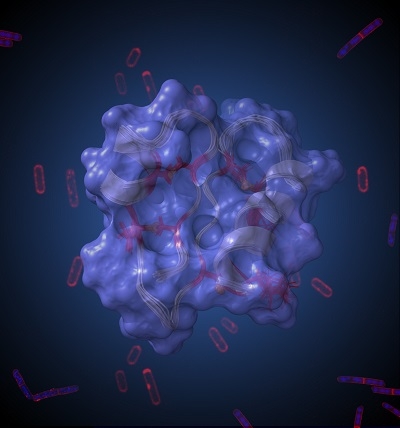Since the discovery of penicillin in 1928, humans have widely developed and used antibiotics to combat microbial infections. However, inappropriate and excessive use of these molecules has led to the emergence of pathogens resistant to many if not all classes of antibiotics. According to the World Health Organization, the world is moving towards an era where common infections will kill again. The WHO predicts that multi-resistant pathogens will cause the death of 10 million people a year by 2050, surpassing the number of cancer-related deaths. It is therefore urgent to develop innovative strategies and find new effective molecules.
Researchers from the Institut des Sciences Moléculaires in Marseille and from our laboratoiry are interested in
Ruminococcus gnavus, a bacterium that lives in symbiosis in our digestive tract, for its ability to produce antimicrobial peptides such as ruminococcin C1 (RumC1). Scientists have successfully reproduced this naturally occurring peptide in the laboratory to study its structure and therapeutic potential.
The three-dimensional structure of RumC1, resolved by RMN in collaboration with the Institut de Microbiologie de la Méditerranée, reveals a very compact double hairpin motif, not described so far. This structure confers to RumC1 very interesting characteristics, which are often lacking in antimicrobial peptides to be considered in clinical development, notably a high resistance to physiological conditions and various physico-chemical treatments. These points are also crucial for the large-scale production of RumC1 and the exploitation of its full therapeutic potential.
RumC1 has key properties for a drug candidate intended to treat intestinal infections, notably because it is active at very low doses against antibiotic-resistant clinical pathogens of the intestine and is effective under conditions mimicking the intestinal environment. In addition, RumC1 has shown no toxicity to intestinal tissues.
Researchers are currently working to elucidate the mode of action and to identify the cellular target of this original molecule in the fight against antibiotic resistance.

Artistic representation of the 3D structure of the antimicrobial peptide RumC1 resolved by nuclear magnetic resonance.
This compact double hairpin structure gives RumC1 important clinical properties, including a remarkable bactericidal activity against pathogens that are multi-drug resistant to the current antibiotics.
© Clarisse Roblin & Matthieu Nouailler